Analysis of Employer Associations and Modern Awards in Australia
VerifiedAdded on 2020/03/16
|9
|2564
|42
Essay
AI Summary
This essay analyzes the role of employer associations in shaping the modern awards system in Australia. It explores the associations' advocacy for changes to penalty rates, flexibility, and managerial prerogative, often prioritizing cost minimization. The discussion delves into the debates surrounding these issues, highlighting the perspectives of employers, employee associations, and the Fair Work Commission. Key themes include the impact of penalty rates on industries like retail and tourism, the concept of managerial prerogative versus productivity, and the influence of the Fair Work Act. The essay concludes that employer associations often prioritize managerial control and cost-cutting over productivity and performance, impacting workplace conditions and potentially affecting the economic landscape, particularly in rural Australia. The analysis underscores the complex interplay between employer associations, modern awards, and the evolving dynamics of the Australian labor market.

Employer Associations and Modern Awards 1
Employer Associations and Modern Awards
Student’s name
Course
University
Date
Employer Associations and Modern Awards
Student’s name
Course
University
Date
Paraphrase This Document
Need a fresh take? Get an instant paraphrase of this document with our AI Paraphraser
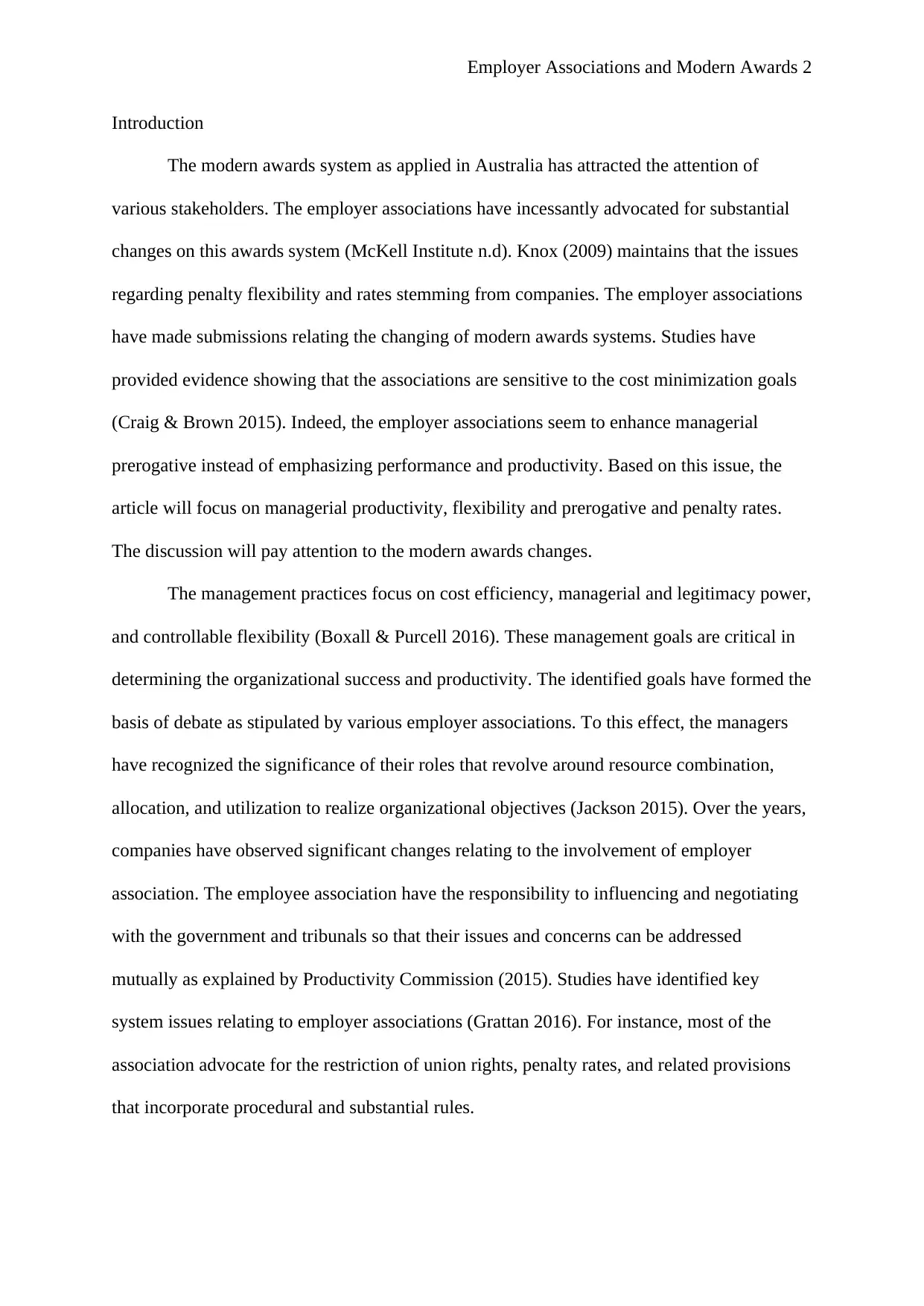
Employer Associations and Modern Awards 2
Introduction
The modern awards system as applied in Australia has attracted the attention of
various stakeholders. The employer associations have incessantly advocated for substantial
changes on this awards system (McKell Institute n.d). Knox (2009) maintains that the issues
regarding penalty flexibility and rates stemming from companies. The employer associations
have made submissions relating the changing of modern awards systems. Studies have
provided evidence showing that the associations are sensitive to the cost minimization goals
(Craig & Brown 2015). Indeed, the employer associations seem to enhance managerial
prerogative instead of emphasizing performance and productivity. Based on this issue, the
article will focus on managerial productivity, flexibility and prerogative and penalty rates.
The discussion will pay attention to the modern awards changes.
The management practices focus on cost efficiency, managerial and legitimacy power,
and controllable flexibility (Boxall & Purcell 2016). These management goals are critical in
determining the organizational success and productivity. The identified goals have formed the
basis of debate as stipulated by various employer associations. To this effect, the managers
have recognized the significance of their roles that revolve around resource combination,
allocation, and utilization to realize organizational objectives (Jackson 2015). Over the years,
companies have observed significant changes relating to the involvement of employer
association. The employee association have the responsibility to influencing and negotiating
with the government and tribunals so that their issues and concerns can be addressed
mutually as explained by Productivity Commission (2015). Studies have identified key
system issues relating to employer associations (Grattan 2016). For instance, most of the
association advocate for the restriction of union rights, penalty rates, and related provisions
that incorporate procedural and substantial rules.
Introduction
The modern awards system as applied in Australia has attracted the attention of
various stakeholders. The employer associations have incessantly advocated for substantial
changes on this awards system (McKell Institute n.d). Knox (2009) maintains that the issues
regarding penalty flexibility and rates stemming from companies. The employer associations
have made submissions relating the changing of modern awards systems. Studies have
provided evidence showing that the associations are sensitive to the cost minimization goals
(Craig & Brown 2015). Indeed, the employer associations seem to enhance managerial
prerogative instead of emphasizing performance and productivity. Based on this issue, the
article will focus on managerial productivity, flexibility and prerogative and penalty rates.
The discussion will pay attention to the modern awards changes.
The management practices focus on cost efficiency, managerial and legitimacy power,
and controllable flexibility (Boxall & Purcell 2016). These management goals are critical in
determining the organizational success and productivity. The identified goals have formed the
basis of debate as stipulated by various employer associations. To this effect, the managers
have recognized the significance of their roles that revolve around resource combination,
allocation, and utilization to realize organizational objectives (Jackson 2015). Over the years,
companies have observed significant changes relating to the involvement of employer
association. The employee association have the responsibility to influencing and negotiating
with the government and tribunals so that their issues and concerns can be addressed
mutually as explained by Productivity Commission (2015). Studies have identified key
system issues relating to employer associations (Grattan 2016). For instance, most of the
association advocate for the restriction of union rights, penalty rates, and related provisions
that incorporate procedural and substantial rules.
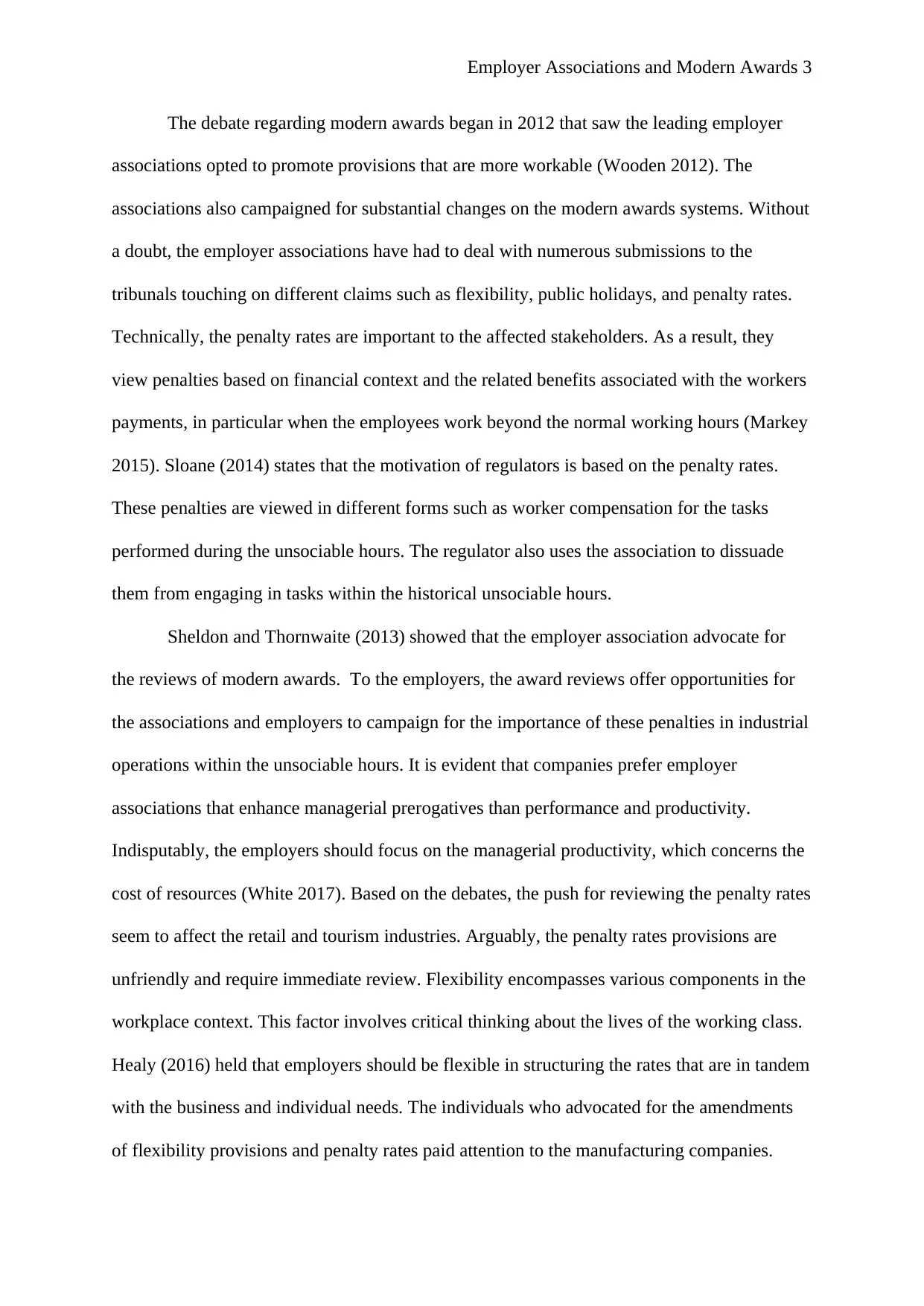
Employer Associations and Modern Awards 3
The debate regarding modern awards began in 2012 that saw the leading employer
associations opted to promote provisions that are more workable (Wooden 2012). The
associations also campaigned for substantial changes on the modern awards systems. Without
a doubt, the employer associations have had to deal with numerous submissions to the
tribunals touching on different claims such as flexibility, public holidays, and penalty rates.
Technically, the penalty rates are important to the affected stakeholders. As a result, they
view penalties based on financial context and the related benefits associated with the workers
payments, in particular when the employees work beyond the normal working hours (Markey
2015). Sloane (2014) states that the motivation of regulators is based on the penalty rates.
These penalties are viewed in different forms such as worker compensation for the tasks
performed during the unsociable hours. The regulator also uses the association to dissuade
them from engaging in tasks within the historical unsociable hours.
Sheldon and Thornwaite (2013) showed that the employer association advocate for
the reviews of modern awards. To the employers, the award reviews offer opportunities for
the associations and employers to campaign for the importance of these penalties in industrial
operations within the unsociable hours. It is evident that companies prefer employer
associations that enhance managerial prerogatives than performance and productivity.
Indisputably, the employers should focus on the managerial productivity, which concerns the
cost of resources (White 2017). Based on the debates, the push for reviewing the penalty rates
seem to affect the retail and tourism industries. Arguably, the penalty rates provisions are
unfriendly and require immediate review. Flexibility encompasses various components in the
workplace context. This factor involves critical thinking about the lives of the working class.
Healy (2016) held that employers should be flexible in structuring the rates that are in tandem
with the business and individual needs. The individuals who advocated for the amendments
of flexibility provisions and penalty rates paid attention to the manufacturing companies.
The debate regarding modern awards began in 2012 that saw the leading employer
associations opted to promote provisions that are more workable (Wooden 2012). The
associations also campaigned for substantial changes on the modern awards systems. Without
a doubt, the employer associations have had to deal with numerous submissions to the
tribunals touching on different claims such as flexibility, public holidays, and penalty rates.
Technically, the penalty rates are important to the affected stakeholders. As a result, they
view penalties based on financial context and the related benefits associated with the workers
payments, in particular when the employees work beyond the normal working hours (Markey
2015). Sloane (2014) states that the motivation of regulators is based on the penalty rates.
These penalties are viewed in different forms such as worker compensation for the tasks
performed during the unsociable hours. The regulator also uses the association to dissuade
them from engaging in tasks within the historical unsociable hours.
Sheldon and Thornwaite (2013) showed that the employer association advocate for
the reviews of modern awards. To the employers, the award reviews offer opportunities for
the associations and employers to campaign for the importance of these penalties in industrial
operations within the unsociable hours. It is evident that companies prefer employer
associations that enhance managerial prerogatives than performance and productivity.
Indisputably, the employers should focus on the managerial productivity, which concerns the
cost of resources (White 2017). Based on the debates, the push for reviewing the penalty rates
seem to affect the retail and tourism industries. Arguably, the penalty rates provisions are
unfriendly and require immediate review. Flexibility encompasses various components in the
workplace context. This factor involves critical thinking about the lives of the working class.
Healy (2016) held that employers should be flexible in structuring the rates that are in tandem
with the business and individual needs. The individuals who advocated for the amendments
of flexibility provisions and penalty rates paid attention to the manufacturing companies.
⊘ This is a preview!⊘
Do you want full access?
Subscribe today to unlock all pages.

Trusted by 1+ million students worldwide
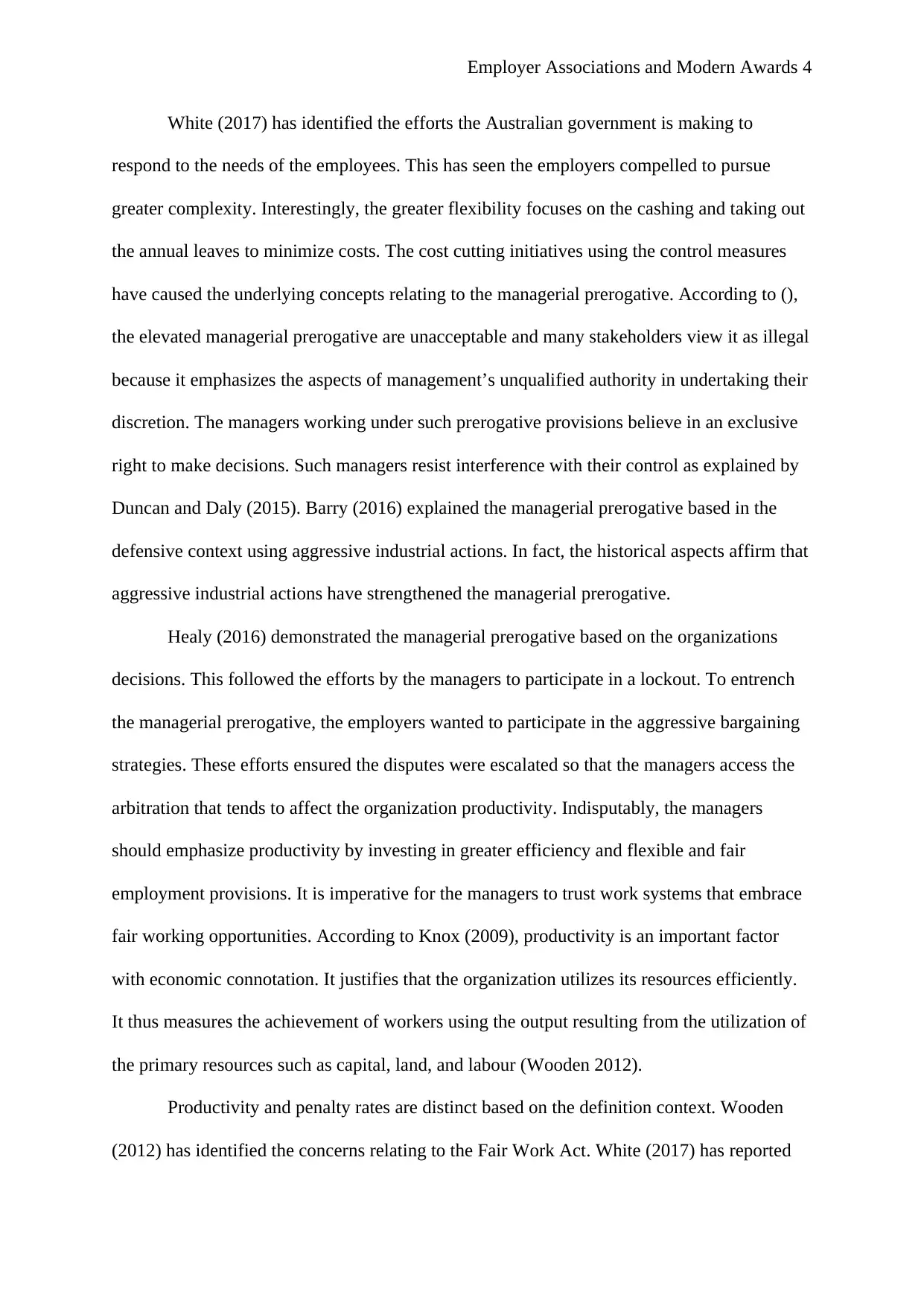
Employer Associations and Modern Awards 4
White (2017) has identified the efforts the Australian government is making to
respond to the needs of the employees. This has seen the employers compelled to pursue
greater complexity. Interestingly, the greater flexibility focuses on the cashing and taking out
the annual leaves to minimize costs. The cost cutting initiatives using the control measures
have caused the underlying concepts relating to the managerial prerogative. According to (),
the elevated managerial prerogative are unacceptable and many stakeholders view it as illegal
because it emphasizes the aspects of management’s unqualified authority in undertaking their
discretion. The managers working under such prerogative provisions believe in an exclusive
right to make decisions. Such managers resist interference with their control as explained by
Duncan and Daly (2015). Barry (2016) explained the managerial prerogative based in the
defensive context using aggressive industrial actions. In fact, the historical aspects affirm that
aggressive industrial actions have strengthened the managerial prerogative.
Healy (2016) demonstrated the managerial prerogative based on the organizations
decisions. This followed the efforts by the managers to participate in a lockout. To entrench
the managerial prerogative, the employers wanted to participate in the aggressive bargaining
strategies. These efforts ensured the disputes were escalated so that the managers access the
arbitration that tends to affect the organization productivity. Indisputably, the managers
should emphasize productivity by investing in greater efficiency and flexible and fair
employment provisions. It is imperative for the managers to trust work systems that embrace
fair working opportunities. According to Knox (2009), productivity is an important factor
with economic connotation. It justifies that the organization utilizes its resources efficiently.
It thus measures the achievement of workers using the output resulting from the utilization of
the primary resources such as capital, land, and labour (Wooden 2012).
Productivity and penalty rates are distinct based on the definition context. Wooden
(2012) has identified the concerns relating to the Fair Work Act. White (2017) has reported
White (2017) has identified the efforts the Australian government is making to
respond to the needs of the employees. This has seen the employers compelled to pursue
greater complexity. Interestingly, the greater flexibility focuses on the cashing and taking out
the annual leaves to minimize costs. The cost cutting initiatives using the control measures
have caused the underlying concepts relating to the managerial prerogative. According to (),
the elevated managerial prerogative are unacceptable and many stakeholders view it as illegal
because it emphasizes the aspects of management’s unqualified authority in undertaking their
discretion. The managers working under such prerogative provisions believe in an exclusive
right to make decisions. Such managers resist interference with their control as explained by
Duncan and Daly (2015). Barry (2016) explained the managerial prerogative based in the
defensive context using aggressive industrial actions. In fact, the historical aspects affirm that
aggressive industrial actions have strengthened the managerial prerogative.
Healy (2016) demonstrated the managerial prerogative based on the organizations
decisions. This followed the efforts by the managers to participate in a lockout. To entrench
the managerial prerogative, the employers wanted to participate in the aggressive bargaining
strategies. These efforts ensured the disputes were escalated so that the managers access the
arbitration that tends to affect the organization productivity. Indisputably, the managers
should emphasize productivity by investing in greater efficiency and flexible and fair
employment provisions. It is imperative for the managers to trust work systems that embrace
fair working opportunities. According to Knox (2009), productivity is an important factor
with economic connotation. It justifies that the organization utilizes its resources efficiently.
It thus measures the achievement of workers using the output resulting from the utilization of
the primary resources such as capital, land, and labour (Wooden 2012).
Productivity and penalty rates are distinct based on the definition context. Wooden
(2012) has identified the concerns relating to the Fair Work Act. White (2017) has reported
Paraphrase This Document
Need a fresh take? Get an instant paraphrase of this document with our AI Paraphraser
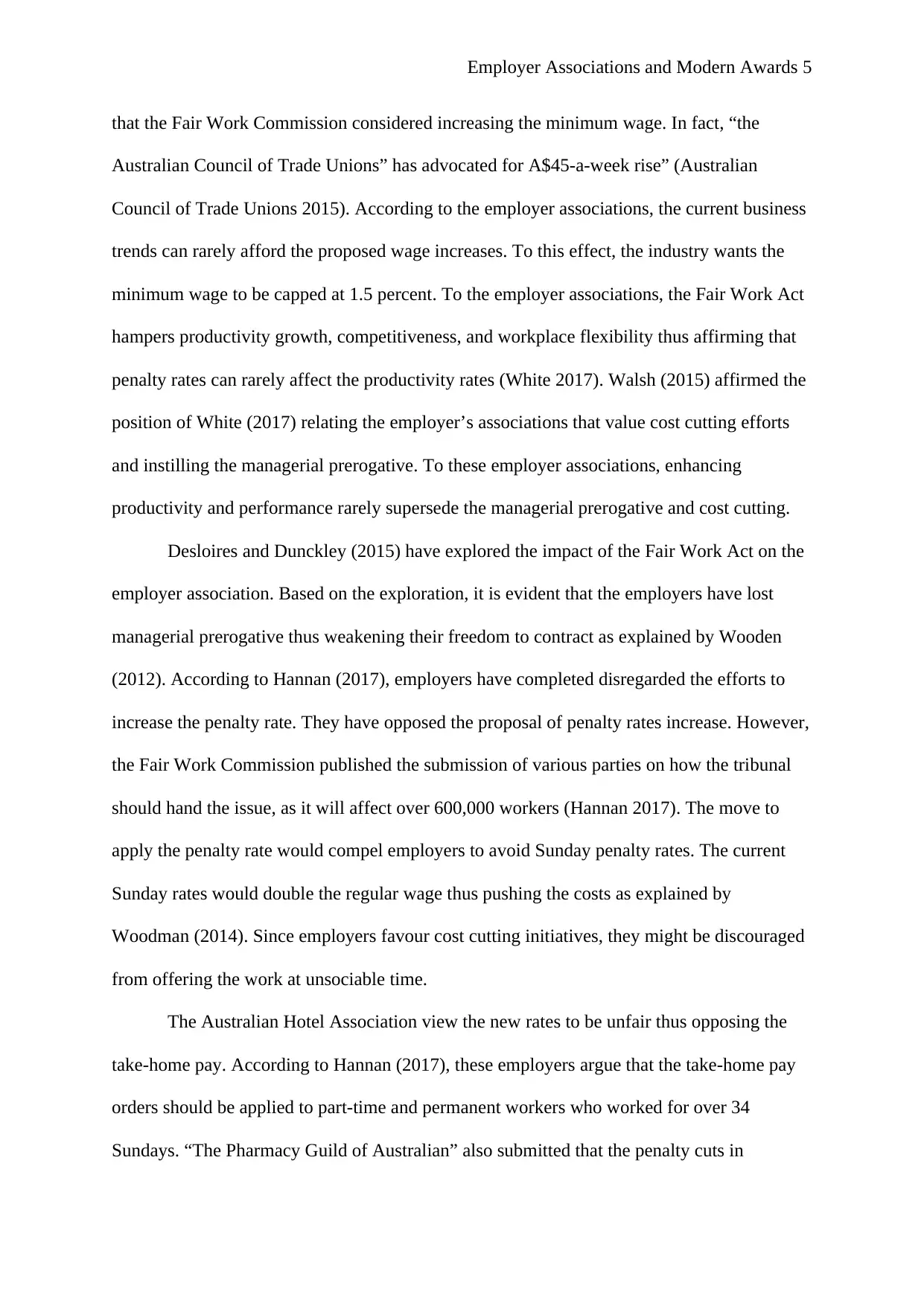
Employer Associations and Modern Awards 5
that the Fair Work Commission considered increasing the minimum wage. In fact, “the
Australian Council of Trade Unions” has advocated for A$45-a-week rise” (Australian
Council of Trade Unions 2015). According to the employer associations, the current business
trends can rarely afford the proposed wage increases. To this effect, the industry wants the
minimum wage to be capped at 1.5 percent. To the employer associations, the Fair Work Act
hampers productivity growth, competitiveness, and workplace flexibility thus affirming that
penalty rates can rarely affect the productivity rates (White 2017). Walsh (2015) affirmed the
position of White (2017) relating the employer’s associations that value cost cutting efforts
and instilling the managerial prerogative. To these employer associations, enhancing
productivity and performance rarely supersede the managerial prerogative and cost cutting.
Desloires and Dunckley (2015) have explored the impact of the Fair Work Act on the
employer association. Based on the exploration, it is evident that the employers have lost
managerial prerogative thus weakening their freedom to contract as explained by Wooden
(2012). According to Hannan (2017), employers have completed disregarded the efforts to
increase the penalty rate. They have opposed the proposal of penalty rates increase. However,
the Fair Work Commission published the submission of various parties on how the tribunal
should hand the issue, as it will affect over 600,000 workers (Hannan 2017). The move to
apply the penalty rate would compel employers to avoid Sunday penalty rates. The current
Sunday rates would double the regular wage thus pushing the costs as explained by
Woodman (2014). Since employers favour cost cutting initiatives, they might be discouraged
from offering the work at unsociable time.
The Australian Hotel Association view the new rates to be unfair thus opposing the
take-home pay. According to Hannan (2017), these employers argue that the take-home pay
orders should be applied to part-time and permanent workers who worked for over 34
Sundays. “The Pharmacy Guild of Australian” also submitted that the penalty cuts in
that the Fair Work Commission considered increasing the minimum wage. In fact, “the
Australian Council of Trade Unions” has advocated for A$45-a-week rise” (Australian
Council of Trade Unions 2015). According to the employer associations, the current business
trends can rarely afford the proposed wage increases. To this effect, the industry wants the
minimum wage to be capped at 1.5 percent. To the employer associations, the Fair Work Act
hampers productivity growth, competitiveness, and workplace flexibility thus affirming that
penalty rates can rarely affect the productivity rates (White 2017). Walsh (2015) affirmed the
position of White (2017) relating the employer’s associations that value cost cutting efforts
and instilling the managerial prerogative. To these employer associations, enhancing
productivity and performance rarely supersede the managerial prerogative and cost cutting.
Desloires and Dunckley (2015) have explored the impact of the Fair Work Act on the
employer association. Based on the exploration, it is evident that the employers have lost
managerial prerogative thus weakening their freedom to contract as explained by Wooden
(2012). According to Hannan (2017), employers have completed disregarded the efforts to
increase the penalty rate. They have opposed the proposal of penalty rates increase. However,
the Fair Work Commission published the submission of various parties on how the tribunal
should hand the issue, as it will affect over 600,000 workers (Hannan 2017). The move to
apply the penalty rate would compel employers to avoid Sunday penalty rates. The current
Sunday rates would double the regular wage thus pushing the costs as explained by
Woodman (2014). Since employers favour cost cutting initiatives, they might be discouraged
from offering the work at unsociable time.
The Australian Hotel Association view the new rates to be unfair thus opposing the
take-home pay. According to Hannan (2017), these employers argue that the take-home pay
orders should be applied to part-time and permanent workers who worked for over 34
Sundays. “The Pharmacy Guild of Australian” also submitted that the penalty cuts in

Employer Associations and Modern Awards 6
instalments could be offset by the current minimum wage (Hannan 2017, par. 4). Hannan
(2017) further identified the Australian Retailers Association and the National Retail
Association supported the penalty cuts but opposed any effort to introduce the take-home pay
orders.
The economic impact of penalty cut will be felt in the hospitality and retail industry.
According to McKell Institute (n.d), the retail and hospitality industry accounts for over
eighteen percent of the rural Australia workforce. This sector employs over 500,000 million.
Therefore, any partial abolition of these penalties would see the rural Australia lose $691.5
million annually. In fact, full abortion of the penalty would impose worse situation to the
rural Australia as they stand to lose $1.55 billion annually (Haynes 2017).
Conclusion
Based on the finding in this article, it has emerged that employer associations are
disappointed with the equitable and productive workplace. The move to cut the penalty rates
has affected the employers across Australia. In fact, the Fair Work Commission has
advocated for an increase of minimum wage. Unfortunately, the employers have remained
adamant to adopt the changes that entrench aspect of productivity and performance. The
employer associations value managerial prerogative instead of enhancing productivity. This
demonstrated that the employers are concerned with their managerial prerogative and cost
cutting. Conversely, the amalgamation of various managerial concepts would enhance
organizational competitiveness. The employer associations made submissions that appear to
have obscured the significance of the issues relating to penalty rate cut, flexibility, and
productivity. Interestingly, the employer associations appear to value the working conditions
of managers at the expense of workforce.
instalments could be offset by the current minimum wage (Hannan 2017, par. 4). Hannan
(2017) further identified the Australian Retailers Association and the National Retail
Association supported the penalty cuts but opposed any effort to introduce the take-home pay
orders.
The economic impact of penalty cut will be felt in the hospitality and retail industry.
According to McKell Institute (n.d), the retail and hospitality industry accounts for over
eighteen percent of the rural Australia workforce. This sector employs over 500,000 million.
Therefore, any partial abolition of these penalties would see the rural Australia lose $691.5
million annually. In fact, full abortion of the penalty would impose worse situation to the
rural Australia as they stand to lose $1.55 billion annually (Haynes 2017).
Conclusion
Based on the finding in this article, it has emerged that employer associations are
disappointed with the equitable and productive workplace. The move to cut the penalty rates
has affected the employers across Australia. In fact, the Fair Work Commission has
advocated for an increase of minimum wage. Unfortunately, the employers have remained
adamant to adopt the changes that entrench aspect of productivity and performance. The
employer associations value managerial prerogative instead of enhancing productivity. This
demonstrated that the employers are concerned with their managerial prerogative and cost
cutting. Conversely, the amalgamation of various managerial concepts would enhance
organizational competitiveness. The employer associations made submissions that appear to
have obscured the significance of the issues relating to penalty rate cut, flexibility, and
productivity. Interestingly, the employer associations appear to value the working conditions
of managers at the expense of workforce.
⊘ This is a preview!⊘
Do you want full access?
Subscribe today to unlock all pages.

Trusted by 1+ million students worldwide
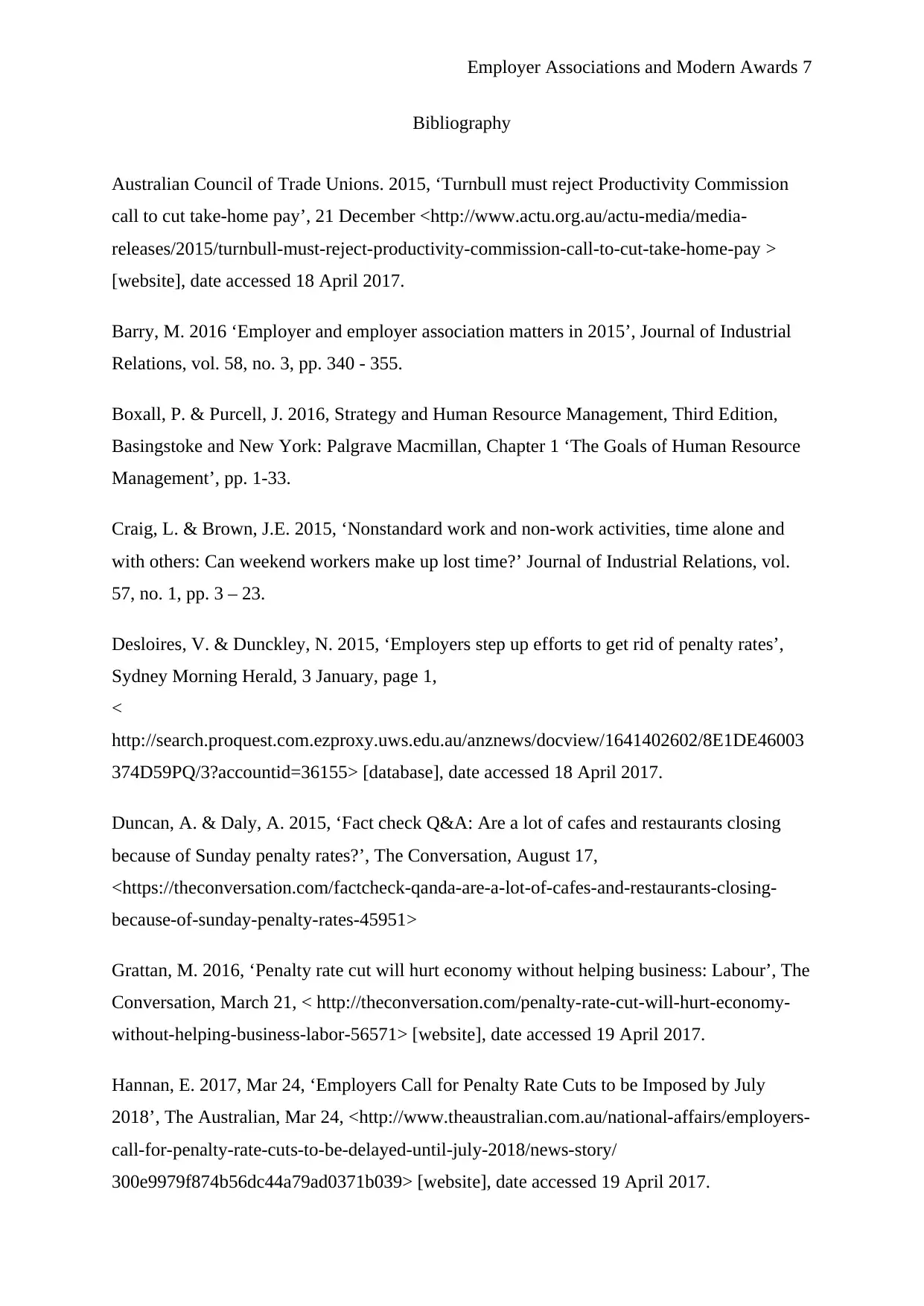
Employer Associations and Modern Awards 7
Bibliography
Australian Council of Trade Unions. 2015, ‘Turnbull must reject Productivity Commission
call to cut take-home pay’, 21 December <http://www.actu.org.au/actu-media/media-
releases/2015/turnbull-must-reject-productivity-commission-call-to-cut-take-home-pay >
[website], date accessed 18 April 2017.
Barry, M. 2016 ‘Employer and employer association matters in 2015’, Journal of Industrial
Relations, vol. 58, no. 3, pp. 340 - 355.
Boxall, P. & Purcell, J. 2016, Strategy and Human Resource Management, Third Edition,
Basingstoke and New York: Palgrave Macmillan, Chapter 1 ‘The Goals of Human Resource
Management’, pp. 1-33.
Craig, L. & Brown, J.E. 2015, ‘Nonstandard work and non-work activities, time alone and
with others: Can weekend workers make up lost time?’ Journal of Industrial Relations, vol.
57, no. 1, pp. 3 – 23.
Desloires, V. & Dunckley, N. 2015, ‘Employers step up efforts to get rid of penalty rates’,
Sydney Morning Herald, 3 January, page 1,
<
http://search.proquest.com.ezproxy.uws.edu.au/anznews/docview/1641402602/8E1DE46003
374D59PQ/3?accountid=36155> [database], date accessed 18 April 2017.
Duncan, A. & Daly, A. 2015, ‘Fact check Q&A: Are a lot of cafes and restaurants closing
because of Sunday penalty rates?’, The Conversation, August 17,
<https://theconversation.com/factcheck-qanda-are-a-lot-of-cafes-and-restaurants-closing-
because-of-sunday-penalty-rates-45951>
Grattan, M. 2016, ‘Penalty rate cut will hurt economy without helping business: Labour’, The
Conversation, March 21, < http://theconversation.com/penalty-rate-cut-will-hurt-economy-
without-helping-business-labor-56571> [website], date accessed 19 April 2017.
Hannan, E. 2017, Mar 24, ‘Employers Call for Penalty Rate Cuts to be Imposed by July
2018’, The Australian, Mar 24, <http://www.theaustralian.com.au/national-affairs/employers-
call-for-penalty-rate-cuts-to-be-delayed-until-july-2018/news-story/
300e9979f874b56dc44a79ad0371b039> [website], date accessed 19 April 2017.
Bibliography
Australian Council of Trade Unions. 2015, ‘Turnbull must reject Productivity Commission
call to cut take-home pay’, 21 December <http://www.actu.org.au/actu-media/media-
releases/2015/turnbull-must-reject-productivity-commission-call-to-cut-take-home-pay >
[website], date accessed 18 April 2017.
Barry, M. 2016 ‘Employer and employer association matters in 2015’, Journal of Industrial
Relations, vol. 58, no. 3, pp. 340 - 355.
Boxall, P. & Purcell, J. 2016, Strategy and Human Resource Management, Third Edition,
Basingstoke and New York: Palgrave Macmillan, Chapter 1 ‘The Goals of Human Resource
Management’, pp. 1-33.
Craig, L. & Brown, J.E. 2015, ‘Nonstandard work and non-work activities, time alone and
with others: Can weekend workers make up lost time?’ Journal of Industrial Relations, vol.
57, no. 1, pp. 3 – 23.
Desloires, V. & Dunckley, N. 2015, ‘Employers step up efforts to get rid of penalty rates’,
Sydney Morning Herald, 3 January, page 1,
<
http://search.proquest.com.ezproxy.uws.edu.au/anznews/docview/1641402602/8E1DE46003
374D59PQ/3?accountid=36155> [database], date accessed 18 April 2017.
Duncan, A. & Daly, A. 2015, ‘Fact check Q&A: Are a lot of cafes and restaurants closing
because of Sunday penalty rates?’, The Conversation, August 17,
<https://theconversation.com/factcheck-qanda-are-a-lot-of-cafes-and-restaurants-closing-
because-of-sunday-penalty-rates-45951>
Grattan, M. 2016, ‘Penalty rate cut will hurt economy without helping business: Labour’, The
Conversation, March 21, < http://theconversation.com/penalty-rate-cut-will-hurt-economy-
without-helping-business-labor-56571> [website], date accessed 19 April 2017.
Hannan, E. 2017, Mar 24, ‘Employers Call for Penalty Rate Cuts to be Imposed by July
2018’, The Australian, Mar 24, <http://www.theaustralian.com.au/national-affairs/employers-
call-for-penalty-rate-cuts-to-be-delayed-until-july-2018/news-story/
300e9979f874b56dc44a79ad0371b039> [website], date accessed 19 April 2017.
Paraphrase This Document
Need a fresh take? Get an instant paraphrase of this document with our AI Paraphraser

Employer Associations and Modern Awards 8
Healy, J. 2016, ‘The Australian labour market in 2015’, Journal of Industrial Relations, vol.
58, no. 3, pp. 308 – 323.
Jackson, S. 2015, ‘Frozen wages, insecure jobs, struggling youth, rising inequality, shrinking
unions… join the dots’, The Conversation, November 26,
<https://theconversation.com/frozen-wages-insecure-jobs-struggling-youth-rising-inequality-
shrinking-unions-join-the-dots-50981 > [website], date accessed 20 April 2017.
Knox, A. 2009, ‘Better the devil you know? An analysis of employers’ bargaining
preferences in the Australian hotel industry’, Journal of Industrial Relations, vol. 51, no. 1,
pp. 25-44.
Markey, R. 2015, ‘Myths about penalty rates and those who rely on them’, The Conversation,
November 16, <https://theconversation.com/myths-about-penalty-rates-and-those-who-rely-
on-them-49947> [website], date accessed 19 April 2017.
McKell Institute. (n.d), Who loses when penalty rates are cut? The economic impact of
penalty rate cuts in Australia’s retail and hospitality industries.
<http://www.sda.org.au/download/industrial-research/The-McKell-Institute-Report-Who-
Loses-Penalty-Rates-Are-Cut.pdf> [website], date accessed 19 April 2017.
Productivity Commission. 2015, ‘Workplace Relations Framework Final Report’,
Productivity Commission Inquiry Report, vol. 1, no. 76, 30 November, Commonwealth of
Australia, Canberra. <http://www.pc.gov.au/inquiries/completed/workplace-relations/report>
[website], date accessed 19 April 2017.
Sheldon, P. & Thornthwaite, L. 2013, ‘Employer and employer association matters in 2012’,
Journal of Industrial Relations, vol. 55, no. 3, pp. 386-402.
Sloane, J. 2014, ‘Pay penalty rates, but not through awards system.
Walsh, L. 2015, ‘A day of rest: the costs of removing penalty rates’, The Conversation, 3
February, <http://theconversation.com/a-day-of-rest-the-costs-of-removing-penalty-rates-
36911> [website], date accessed 18 April 2017.
Healy, J. 2016, ‘The Australian labour market in 2015’, Journal of Industrial Relations, vol.
58, no. 3, pp. 308 – 323.
Jackson, S. 2015, ‘Frozen wages, insecure jobs, struggling youth, rising inequality, shrinking
unions… join the dots’, The Conversation, November 26,
<https://theconversation.com/frozen-wages-insecure-jobs-struggling-youth-rising-inequality-
shrinking-unions-join-the-dots-50981 > [website], date accessed 20 April 2017.
Knox, A. 2009, ‘Better the devil you know? An analysis of employers’ bargaining
preferences in the Australian hotel industry’, Journal of Industrial Relations, vol. 51, no. 1,
pp. 25-44.
Markey, R. 2015, ‘Myths about penalty rates and those who rely on them’, The Conversation,
November 16, <https://theconversation.com/myths-about-penalty-rates-and-those-who-rely-
on-them-49947> [website], date accessed 19 April 2017.
McKell Institute. (n.d), Who loses when penalty rates are cut? The economic impact of
penalty rate cuts in Australia’s retail and hospitality industries.
<http://www.sda.org.au/download/industrial-research/The-McKell-Institute-Report-Who-
Loses-Penalty-Rates-Are-Cut.pdf> [website], date accessed 19 April 2017.
Productivity Commission. 2015, ‘Workplace Relations Framework Final Report’,
Productivity Commission Inquiry Report, vol. 1, no. 76, 30 November, Commonwealth of
Australia, Canberra. <http://www.pc.gov.au/inquiries/completed/workplace-relations/report>
[website], date accessed 19 April 2017.
Sheldon, P. & Thornthwaite, L. 2013, ‘Employer and employer association matters in 2012’,
Journal of Industrial Relations, vol. 55, no. 3, pp. 386-402.
Sloane, J. 2014, ‘Pay penalty rates, but not through awards system.
Walsh, L. 2015, ‘A day of rest: the costs of removing penalty rates’, The Conversation, 3
February, <http://theconversation.com/a-day-of-rest-the-costs-of-removing-penalty-rates-
36911> [website], date accessed 18 April 2017.
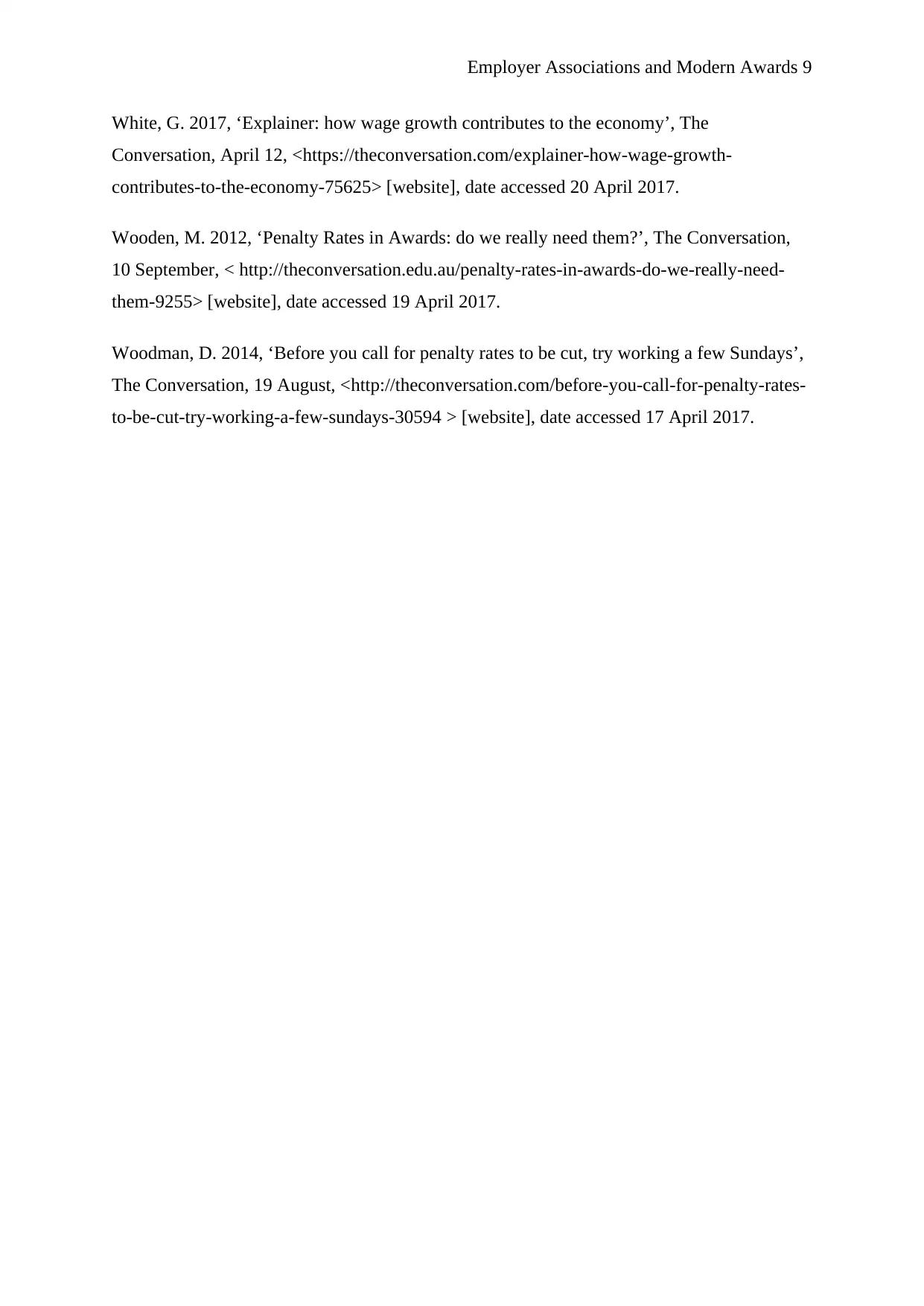
Employer Associations and Modern Awards 9
White, G. 2017, ‘Explainer: how wage growth contributes to the economy’, The
Conversation, April 12, <https://theconversation.com/explainer-how-wage-growth-
contributes-to-the-economy-75625> [website], date accessed 20 April 2017.
Wooden, M. 2012, ‘Penalty Rates in Awards: do we really need them?’, The Conversation,
10 September, < http://theconversation.edu.au/penalty-rates-in-awards-do-we-really-need-
them-9255> [website], date accessed 19 April 2017.
Woodman, D. 2014, ‘Before you call for penalty rates to be cut, try working a few Sundays’,
The Conversation, 19 August, <http://theconversation.com/before-you-call-for-penalty-rates-
to-be-cut-try-working-a-few-sundays-30594 > [website], date accessed 17 April 2017.
White, G. 2017, ‘Explainer: how wage growth contributes to the economy’, The
Conversation, April 12, <https://theconversation.com/explainer-how-wage-growth-
contributes-to-the-economy-75625> [website], date accessed 20 April 2017.
Wooden, M. 2012, ‘Penalty Rates in Awards: do we really need them?’, The Conversation,
10 September, < http://theconversation.edu.au/penalty-rates-in-awards-do-we-really-need-
them-9255> [website], date accessed 19 April 2017.
Woodman, D. 2014, ‘Before you call for penalty rates to be cut, try working a few Sundays’,
The Conversation, 19 August, <http://theconversation.com/before-you-call-for-penalty-rates-
to-be-cut-try-working-a-few-sundays-30594 > [website], date accessed 17 April 2017.
⊘ This is a preview!⊘
Do you want full access?
Subscribe today to unlock all pages.

Trusted by 1+ million students worldwide
1 out of 9
Your All-in-One AI-Powered Toolkit for Academic Success.
+13062052269
info@desklib.com
Available 24*7 on WhatsApp / Email
![[object Object]](/_next/static/media/star-bottom.7253800d.svg)
Unlock your academic potential
Copyright © 2020–2025 A2Z Services. All Rights Reserved. Developed and managed by ZUCOL.
